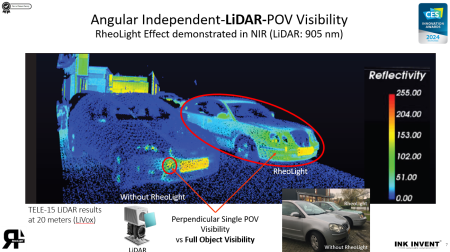Our members are dedicated to improving road safety and sharing their knowledge with the wider community. Here, you can explore our members' good practices – initiatives that have been assessed for their effectiveness in addressing a road safety problem and have proven results.
Get inspired – and sign up to share your good practices too!

Friday, June 21, 2024
We are solving the two main unsettled topics in Camera and LiDAR Systems and human vision in traffic situations. The internally developed Visibility Label, featuring a new universally applicable reference color, addresses the first topic, which is the lack of a universal method for quantifying the visibility of complex shapes such as cars, bikes, and busses. Crystal Glass Pigments provide a solution for the second unresolved issue, focusing on improving the functionality (i.e. visibility) of coatings on vehicles. By formulating new colors with this innovative additive, the coatings become significantly better visible for camera systems, human vision at night, and LiDAR systems 24/7.

Friday, June 21, 2024
1. Sistemas poco eficaces de reporte de accidentes o averías.
Ahora con Incidence APP se agiliza el reporte de las incidencias, enviando a la aseguradora de manera inmediata la información detallada y precisa que necesita sobre el siniestro sin que el conductor tenga que buscar datos (nº de póliza, teléfonos, etc) en el momento de más estrés. Además, la digitalización del seguimiento en tiempo real y el tratamiento personalizado de los datos permiten una evaluación más rápida y precisa de los daños, reduciendo los costos administrativos y mejorando la eficiencia operativa.
2. Tiempos de respuesta mejorables y falta de precisión con la ubicación del incidente.
La aplicación utiliza la geolocalización para proporcionar la ubicación exacta del incidente. Esto permite a la asistencia acudir al lugar preciso sin demoras, lo cual es crucial para ofrecer un servicio de asistencia en carretera eficiente, sobre todo en caso de que ocurra un incidente con heridos. El reporte se agiliza aún más vinculando la app con una luz de emergencia V16 compatible, como Help Flash IoT.
3. No se aprovecha la data para la prevención de nuevos accidentes.
La aplicación recoge datos que podrán ser analizados por las aseguradoras para identificar patrones y áreas de alto riesgo. Esto les permite implementar estrategias de prevención y ofrecer recomendaciones personalizadas a sus clientes, lo que puede reducir la frecuencia y la gravedad de los accidentes.
Ahora con Incidence APP se agiliza el reporte de las incidencias, enviando a la aseguradora de manera inmediata la información detallada y precisa que necesita sobre el siniestro sin que el conductor tenga que buscar datos (nº de póliza, teléfonos, etc) en el momento de más estrés. Además, la digitalización del seguimiento en tiempo real y el tratamiento personalizado de los datos permiten una evaluación más rápida y precisa de los daños, reduciendo los costos administrativos y mejorando la eficiencia operativa.
2. Tiempos de respuesta mejorables y falta de precisión con la ubicación del incidente.
La aplicación utiliza la geolocalización para proporcionar la ubicación exacta del incidente. Esto permite a la asistencia acudir al lugar preciso sin demoras, lo cual es crucial para ofrecer un servicio de asistencia en carretera eficiente, sobre todo en caso de que ocurra un incidente con heridos. El reporte se agiliza aún más vinculando la app con una luz de emergencia V16 compatible, como Help Flash IoT.
3. No se aprovecha la data para la prevención de nuevos accidentes.
La aplicación recoge datos que podrán ser analizados por las aseguradoras para identificar patrones y áreas de alto riesgo. Esto les permite implementar estrategias de prevención y ofrecer recomendaciones personalizadas a sus clientes, lo que puede reducir la frecuencia y la gravedad de los accidentes.

Friday, June 21, 2024
Please describe the main road safety challenges/ problems you have addressed or are addressing? (approximately 200 words) De belangrijkste uitdaging is ervoor te zorgen dat zoveel mogelijk kinderen met de fiets naar school gaan. Ons doelpubliek is de leerlingengroep tussen 12 en 18 jaar.
De 12-jarigen komen in september pas uit het basisonderwijs en de weg naar de secundaire school is meestal ook langer en risicovoller. Een veilige fiets met goede verlichting is heel belangrijk. Fietsvaardigheid en uithouding zijn eveneens belangrijk. De leerlingen bewust maken dat zo op die fiets ook zichtbaar moeten zijn is voor XIU de grootste uitdaging. Vooral bij duistere en mistige momenten ben je als autobestuurder heel dankbaar dat de fietsers goed opgemerkt worden. Een fluohesje doet wonderen.
Bij de leeftijdsgroep 12-14 jaar lukt de motivatie voor het dragen van het hesje perfect. Aan de schoolpoort worden tijdens de donkere dagen acties gedaan met hulp van de ouders. XIU zorgt voor de beloning als de leerlingen goed zichtbaar zijn.
De groep tussen 14-16 jaar is de moeilijkste groep om te overtuigen. XIU probeert op een ludieke manier ook deze leerlingengroep over de streep te krijgen. Deze leeftijdsgroep kan ingeschakeld worden om in plaats van de ouders maar samen met de verkeersverantwoordelijke van de school de fluocontroles te organiseren. Een beker warme chocomelk, een warme wafel of zelfs oliebollen bij het aankomen op school kunnen het dragen van het hesje stimuleren.
Voor de laatste groep tussen 16 en 18 jaar beginnen de autorijlessen. Jammer genoeg beseffen ze pas echt hoe belangrijk het is om goed gezien op weg te gaan, als ze zelf achter het stuur zitten.
Scholen van kleuter tot en met hoger onderwijs, steden en gemeenten, overheid, politiezones, bedrijven, organisaties kortom elke burger wordt elk jaar opnieuw uitgenodigd mee te doen aan de nationale Fluodag=zichtbaarheidsdag.
De 12-jarigen komen in september pas uit het basisonderwijs en de weg naar de secundaire school is meestal ook langer en risicovoller. Een veilige fiets met goede verlichting is heel belangrijk. Fietsvaardigheid en uithouding zijn eveneens belangrijk. De leerlingen bewust maken dat zo op die fiets ook zichtbaar moeten zijn is voor XIU de grootste uitdaging. Vooral bij duistere en mistige momenten ben je als autobestuurder heel dankbaar dat de fietsers goed opgemerkt worden. Een fluohesje doet wonderen.
Bij de leeftijdsgroep 12-14 jaar lukt de motivatie voor het dragen van het hesje perfect. Aan de schoolpoort worden tijdens de donkere dagen acties gedaan met hulp van de ouders. XIU zorgt voor de beloning als de leerlingen goed zichtbaar zijn.
De groep tussen 14-16 jaar is de moeilijkste groep om te overtuigen. XIU probeert op een ludieke manier ook deze leerlingengroep over de streep te krijgen. Deze leeftijdsgroep kan ingeschakeld worden om in plaats van de ouders maar samen met de verkeersverantwoordelijke van de school de fluocontroles te organiseren. Een beker warme chocomelk, een warme wafel of zelfs oliebollen bij het aankomen op school kunnen het dragen van het hesje stimuleren.
Voor de laatste groep tussen 16 en 18 jaar beginnen de autorijlessen. Jammer genoeg beseffen ze pas echt hoe belangrijk het is om goed gezien op weg te gaan, als ze zelf achter het stuur zitten.
Scholen van kleuter tot en met hoger onderwijs, steden en gemeenten, overheid, politiezones, bedrijven, organisaties kortom elke burger wordt elk jaar opnieuw uitgenodigd mee te doen aan de nationale Fluodag=zichtbaarheidsdag.

Friday, June 21, 2024
The initiative “NEAR – New Education Approaches for Road Safety” is supported by 4 organisations from 4 countries to strengthen young people’s approaches to road safety in order to prevent deaths and injuries caused by road crashes. Our major objective is to promote safe mobility for young people, to improve their attitudes, habits and behaviour in traffic and to provide psychological support to survivors of traffic collisions and young people who have lost someone close in road crashes. Among young people we identify those who have experienced collisions and, together with other young people we develop preventive, supportive and educational models aimed at improving road safety and supporting the "invisible victims".
The project emphasises the approach of active citizenship to improve traffic safety. The results of the project will enable activities that will encourage young people to take appropriate action for safe mobility. We pay special attention to young people affected by the consequences of traffic crashes.
The project emphasises the approach of active citizenship to improve traffic safety. The results of the project will enable activities that will encourage young people to take appropriate action for safe mobility. We pay special attention to young people affected by the consequences of traffic crashes.

Thursday, June 20, 2024
De belangrijkste uitdaging is dat we naast het zichtbaarheidsverhaal ook willen uitpakken met de andere facetten verbonden aan verkeersveiligheid. We kiezen elk jaar voor een nieuw concept. Een ander concept leert de leerlingen zowel de verkeersveiligheid als de zichtbaarheid vanuit een ander standpunt te bekijken. De nieuwe wedstrijd die we in het schooljaar 2024-2025 zullen aanbieden is het ontwikkelen van een verkeersspel. We denken eraan te gaan voor een participatietraject met de ouders. Afhankelijk van de woonplaats in de stad of buiten de stad ziet het mobiliteitsplan er helemaal anders uit. Jonge gezinnen kiezen voor de stad omdat ze hun mobiliteit vooral afstemmen op de fiets. Vele jonge gezinnen kiezen bewust voor het bannen van de auto en trekken daarom naar de stad. Terwijl gezinnen die zich buiten de stad vestigen meestal aangewezen zijn op de auto om zich te verplaatsen. Hoe zit het met het mobiliteitsgedrag van de kinderen van deze gezinnen? En spelen leeftijd en geslacht een rol? Situaties die het spel interessant kunnen maken.
Veilig en zichtbaar door het verkeer zowel overdag als in het donker is van levensgroot belang en een uitdaging op zich.Dat is trouwens de betekenis van de naam van onze vereniging XIU (sms-taal voor ik zie u). Deze boodschap dragen de leerlingen uit na het bedenken, het ontwerpen en uitvoeren van een opdracht. Een opdracht waar de leerlingen kennis moeten delen met elkaar. Ideeën worden afgetoetst; meningen verschillen en er wordt in overleg met elkaar voor de duidelijkste en meest doelbewuste keuze gezorgd. Een keuze die het meest invloed uitoefent op hun leeftijdsgenoten. De leerlingen krijgen tips van de verkeersverantwoordelijke om bewust te worden van het belang van gezien te zijn in het verkeer. Alternatieve oplossingen zoals het verbeteren van de infrastructuur of veiliger voertuigen behoren tot de mogelijkheden om in de opdracht te verwerken. De leerlingen kunnen deelnemen met een groep of een klas.
Veilig en zichtbaar door het verkeer zowel overdag als in het donker is van levensgroot belang en een uitdaging op zich.Dat is trouwens de betekenis van de naam van onze vereniging XIU (sms-taal voor ik zie u). Deze boodschap dragen de leerlingen uit na het bedenken, het ontwerpen en uitvoeren van een opdracht. Een opdracht waar de leerlingen kennis moeten delen met elkaar. Ideeën worden afgetoetst; meningen verschillen en er wordt in overleg met elkaar voor de duidelijkste en meest doelbewuste keuze gezorgd. Een keuze die het meest invloed uitoefent op hun leeftijdsgenoten. De leerlingen krijgen tips van de verkeersverantwoordelijke om bewust te worden van het belang van gezien te zijn in het verkeer. Alternatieve oplossingen zoals het verbeteren van de infrastructuur of veiliger voertuigen behoren tot de mogelijkheden om in de opdracht te verwerken. De leerlingen kunnen deelnemen met een groep of een klas.